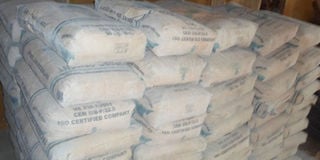Cement dealers to blame for high prices - Hima boss

Prices of cement have in the last three weeks increased from an average of Shs28,000 to more than Shs50,000. FILE PHOTO
What you need to know:
- The current high cement prices is a complex affair which has nothing to do with manufacturers, the Hima Cement country chief executive officer, has said.
- According to Mr George, the new plant which has a capacity of about 800 metric tonnes, will be a good addition, which could help to bring down prices as well as stabilise supply in the market.
- According to experts, the current volatilities in the cement market will need long term planning due to the rapid expansion of demand that is stretching available capacity.
The current high cement prices is a complex affair which has nothing to do with manufacturers, the Hima Cement country chief executive officer, has said.
Speaking in Tororo District at the weekend, Mr Nicola George, the Hima Cement country chief executive, said it was not the producers increasing the price.
“It is the distribution channel that has been impacted,” he said, adding they, as an industry, have been experiencing challenges related to power and low supply of raw material, which have subsequently affected supply volumes.
“Because distributors and retailers are not getting enough volumes they [are rising prices] to have large margins on what they have,” he said.
Cement prices have increased in the last two week from an average of Shs28,000 to more than Shs50,000 for a 50 kilogramme bag.
To reduce on the current pressures, Hima Cement is expected to start production on its $40m (Shs144b) plant by the first week of May, ahead of a planned production schedule of June, according to Mr George.
The cement manufacturer broke ground for the construction of its plant in Tororo District in January last year.
However, yesterday government gave cement manufacturers an ultimatum of three months in which they had to do everything possible to bring down the prices of cement.
In a meeting with cement manufacturer in Kampala yesterday, Ms Amelia Kyambadde, the Trade minister, warned that government would allow cement imports into the country if producers fail to bring down the prices in three months.
According to Mr George, the new plant which has a capacity of about 800 metric tonnes, will be a good addition, which could help to bring down prices as well as stabilise supply in the market.
According to experts, the current volatilities in the cement market will need long term planning due to the rapid expansion of demand that is stretching available capacity.
Three new cement plants are expected to open this year in Tororo, including Hima Cement, Tororo Cement (new 1.8 million metric tonnes plant) and Simba Cement.
The three are projected to increase cement production to 6.8 million metric tonnes per year, up from the current 3.6 metric tonnes.
However, with the local demand currently at 2.4 million metric tonnes per year, experts say there will be an over supply which is expected to drive down the cost of cement.
Declining exports
Exports. According to Uganda Bureau of Statistics cement export earnings grew from $94m (Shs337.9b) in 2011 to $106.8m (Shs383b) in 2012 on account of exports to South Sudan and the eastern DR Congo before dropping to $60.8m in 2016.
Unprecedented. Prices of cement have in the last three weeks increased from an average of Shs28,000 to more than Shs50,000. FILE PHOTO




